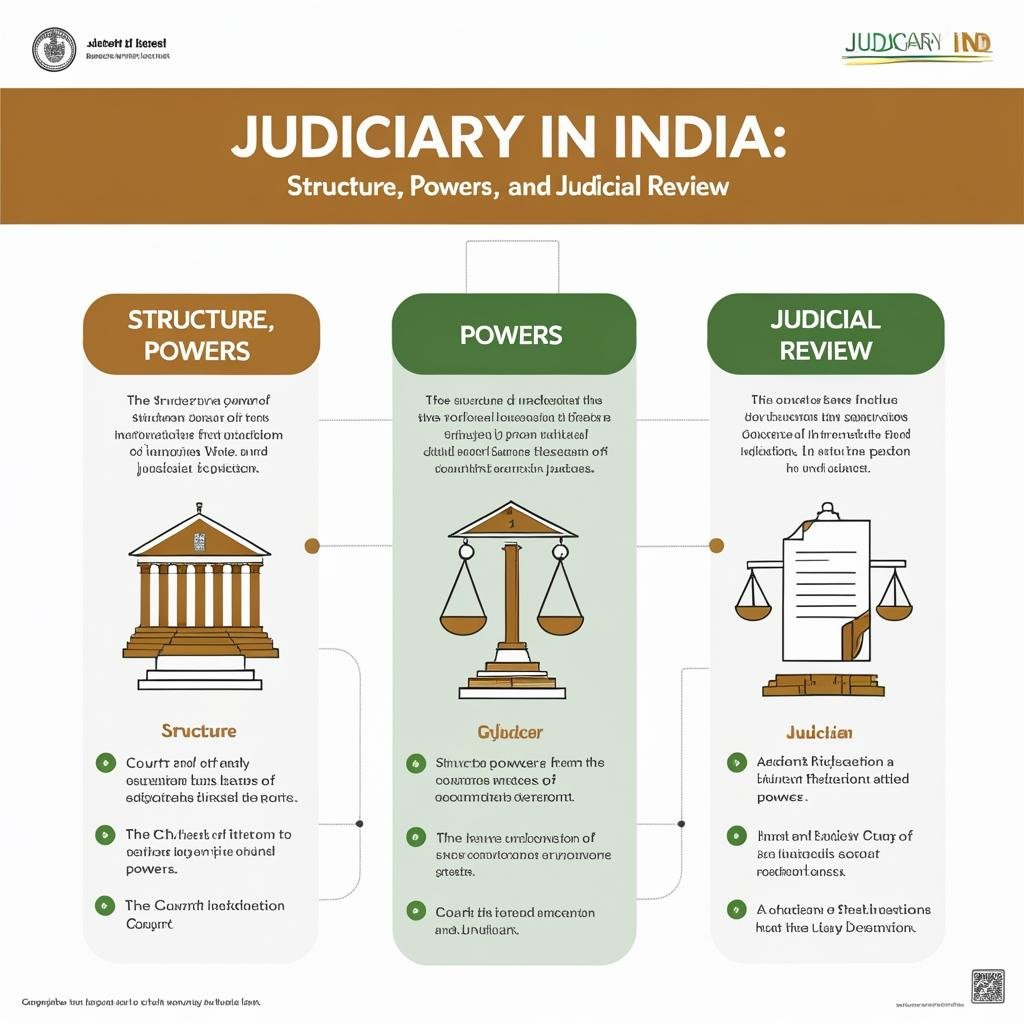1. Introduction
The judiciary of India is the guardian of the Constitution, the protector of fundamental rights, and the ultimate arbiter in disputes between citizens, states, and the Union. Established under Part V, Part VI, and Part IX of the Constitution, it is independent in its functioning yet accountable to the people through constitutional provisions.
The judiciary’s role is pivotal in ensuring that the rule of law prevails over arbitrary actions. For UPSC aspirants, understanding the judiciary’s structure, powers, and judicial review is essential, as it often features in Prelims (Articles, provisions, landmark cases) and Mains (analytical, evaluative questions).
Also Visit – Best IAS Coaching in India
2. Historical Background
- Ancient India: Justice delivery was community-based, with village panchayats playing a major role. The king was the supreme authority but assisted by learned ministers.
- Medieval India: Qazis and Sharia courts in the Mughal era administered justice based on Islamic law.
- British Era:
- Regulating Act, 1773: Established the Supreme Court at Calcutta.
- High Courts Act, 1861: Established High Courts in Bombay, Calcutta, and Madras.
- Government of India Act, 1935: Provided for a Federal Court.
- Post-Independence: The Constitution of India created an integrated judiciary with the Supreme Court at the top, High Courts in states, and subordinate courts.
3. Constitutional Provisions
- Articles 124–147: Supreme Court.
- Articles 214–231: High Courts.
- Articles 233–237: Subordinate Courts.
- Articles 32 & 226: Enforcement of fundamental rights and writ jurisdiction.
- Article 50: Separation of judiciary from the executive.

4. Structure of the Indian Judiciary
India follows a single integrated judicial system:
4.1 Supreme Court of India
- Composition: Chief Justice of India + 33 other judges (may vary by Parliamentary law).
- Appointment: By the President, based on recommendations of the Collegium system.
- Tenure: Till age of 65 years.
- Jurisdiction:
- Original Jurisdiction (Article 131): Disputes between Union & States.
- Appellate Jurisdiction: Civil, criminal, constitutional appeals.
- Advisory Jurisdiction (Article 143): On matters referred by the President.
4.2 High Courts
- Established in states; some serve multiple states/UTs.
- Judges appointed by the President after consultation with the CJI and Governor.
- Tenure: Till age of 62 years.
- Jurisdiction: Original, appellate, and writ jurisdiction.
4.3 Subordinate Courts
- District Courts: Headed by District Judge.
- Magistrate Courts: Handle criminal and civil cases of lower monetary value.
- Special Courts: Family courts, CBI courts, Fast-track courts.
5. Powers and Functions of the Judiciary
5.1 Interpretative Function
- Interprets laws and constitutional provisions.
- Landmark example: Kesavananda Bharati (1973) — Doctrine of Basic Structure.
5.2 Protection of Fundamental Rights
- Through writ jurisdiction (Articles 32 & 226):
- Habeas Corpus
- Mandamus
- Prohibition
- Certiorari
- Quo Warranto
5.3 Dispute Resolution
- Between centre and states, states inter se, and citizens vs. state.
5.4 Judicial Review
- Ensures laws and executive actions conform to the Constitution.
5.5 Judicial Activism
- Taking proactive steps to address public issues.
- Example: Vishaka v. State of Rajasthan (1997) — Guidelines against workplace harassment.
5.6 Judicial Restraint
- Avoiding interference in legislative or executive domains unnecessarily.
6. Judicial Review in India
Judicial review is the power of the judiciary to examine the constitutionality of legislative acts and executive orders. It is derived from the Constitution of India, not merely from precedent (unlike the US where Marbury v. Madison set it up).
6.1 Constitutional Basis
- Article 13: Laws inconsistent with Fundamental Rights are void.
- Article 32 & 226: Power to enforce rights.
- Article 131: Original jurisdiction in disputes.
- Article 136: Special leave to appeal.
- Article 368: Judicial review of constitutional amendments.
6.2 Scope
- Legislative Acts: Striking down unconstitutional laws.
- Executive Orders: Reviewing administrative actions.
- Constitutional Amendments: Limited by the Basic Structure Doctrine.
6.3 Types of Judicial Review
- Review of Legislative Action: Ensuring no violation of fundamental rights.
- Review of Administrative Action: Preventing arbitrariness and ensuring fairness.
- Review of Constitutional Amendments: Basic Structure limitation.
7. Landmark Cases on Judicial Review
- Kesavananda Bharati (1973): Parliament’s power to amend the Constitution is limited by Basic Structure.
- Indira Gandhi v. Raj Narain (1975): Struck down the 39th Amendment curtailing judicial review.
- Minerva Mills (1980): Judicial review is part of the Basic Structure.
- L. Chandra Kumar (1997): Judicial review cannot be excluded even by creating tribunals.
8. Independence of the Judiciary
Ensured through:
- Security of tenure for judges.
- Fixed service conditions.
- Removal only through impeachment (Article 124(4)).
- Prohibition on practice after retirement (for SC judges).
- Separation from executive control.

9. Challenges Faced by the Indian Judiciary
- Pendency of Cases: Over 4.5 crore cases pending.
- Judicial Vacancies: Shortage of judges affects speed.
- Access to Justice: High costs and urban-centric courts.
- Perception of Judicial Overreach: Encroachment into policy-making areas.
- Collegium System Criticism: Lack of transparency in appointments.
- Delay in Infrastructure Modernisation.
10. Reform Measures Suggested
- Filling Judicial Vacancies promptly.
- Strengthening Lower Judiciary with better pay and training.
- E-Courts Project for digitisation.
- All India Judicial Service for uniform recruitment.
- Judicial Accountability Mechanisms to ensure integrity.
- ADR Mechanisms: Mediation, arbitration to reduce burden.
11. UPSC Relevance
Prelims Focus:
- Articles 124–147, 214–231, 32, 226.
- Types of writs.
- Landmark cases.
Mains Angle:
- GS Paper II: “Judicial review is the cornerstone of constitutionalism in India.”
- Essay Topics: “Role of Judiciary in strengthening Indian democracy.”
12. Conclusion
The Indian judiciary is not only a guardian of the Constitution but also a bulwark against arbitrary power. However, its credibility depends on independence, efficiency, and impartiality. Judicial review has ensured that the Constitution remains a living document, adapting to changing times while protecting its core principles. Strengthening this institution is essential for deepening the democratic ethos of India.
For Answer Writing Techniques – Join FIRST IAS INSTITUTE

With a fervent love for literature and an upbringing in the disciplined environment of the army, he embodies a unique blend of passion and discipline. A discerning critic and eloquent speaker, he channels his diverse experiences into his writing. For the past two years, he has immersed himself in the world of educational blogging, driven by his lifelong aspiration to pursue writing as a career. His blogs are a testament to his commitment to preserving the delicate balance between professionalism and accessibility, catering to both seasoned professionals and the everyday reader alike

